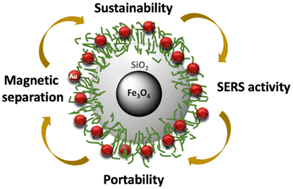Magneto-plasmonic nanosystems have emerged as important multifunctional structures for several sensing applications, including on-site water quality monitoring. In this scenario, these nanosystems can integrate magnetic assisted separation procedures associated with optical detection of water contaminants, by exploring the surface-enhanced Raman scattering effect (SERS). Among the several modalities proposed for such magneto-plasmonic nanosystems, bionanocomposite particles have not been explored in this context. Hence, this research introduces bionanocomposites comprising magnetite cores that have been coupled to Au nanoparticles (NPs) via an intermediate surface modification step using hybrid shells of trimethyl chitosan-SiO2. The magnetic bionanocomposites were decorated with Au NPs by exploring two methods: their assembly with pre-synthesized Au colloids and as heterogeneous substrates for the in situ synthesis of Au NPs. The resulting magneto-plasmonic nanosystems are responsive to an external magnetic gradient and show the localized surface plasmon resonance (LSPR) band ascribed to the Au NPs. Therefore, such multifunctionality was explored here by assessing the SERS performance of the magneto-plasmonic substrates after their use as magnetic nanosorbents for the uptake of organic dyes, specifically methylene blue (MB) and rose bengal (RB), as water contaminant models. The results showed that both types of substrates are effective, though the ex situ bionanocomposites have shown better SERS activity. As such, the latter have been selected to further demonstrate the versatility of the bionanocomposites for the SERS detection of other types of water contaminants, such as salicylic acid (SA), a pharmaceutical compound that is classified as a teratogen substance. Overall, these findings indicate that magneto-plasmonic bionanocomposites, indeed can be explored as more sustainable platforms for analytical purposes, combining the ability for magnetic separation and SERS trace detection.
